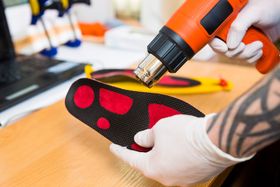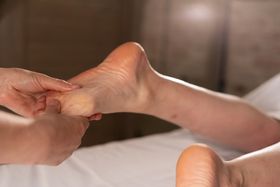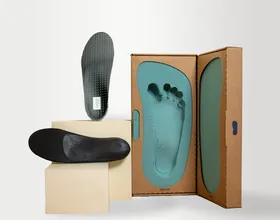6 Worst Shoes for Achilles Tendonitis: Avoid Foot Pain
Is your footwear fueling your foot pain? Discover the worst shoes for Achilles tendonitis and step towards recovery!
Updated July 11, 2025

You love staying active. Walking, hiking, maybe even a little jogging. Lately, however, that sharp pain in your heel has been making it hard to enjoy the things you love. Achilles tendonitis is slowing you down, and you're worried it's only going to get worse.
You've tried everything: rest, ice, stretching. Maybe you've even spent a fortune on those expensive shoe inserts from the drugstore. But the pain keeps coming back. And the worst part? You're starting to think you might have to give up your favorite activities altogether.
What if you could finally kick Achilles tendonitis to the curb and get back to doing the things you love? It starts with understanding which shoes are actually making your pain worse. Below, we'll reveal the worst offenders and show you what to do if you want to stay active and pain-free.
» Don't let pain hold you back—try custom orthotics for Achilles tendonitis
What is Achilles Tendonitis?
The Achilles tendon, connecting your calf muscles to your heel bone, is vital for movement. Achilles tendonitis occurs when this tendon becomes inflamed, often due to overuse, improper footwear, or sudden increases in activity.
The primary symptoms are pain and stiffness at the back of the ankle, which worsen after activity. If ignored, it can become chronic and increase the risk of a tendon rupture.
Here are 3 key factors that can make you more prone to Achilles tendonitis:
1. Age
As you get older, your body's ability to repair and replace tissues declines. This affects the Achilles tendon, making it less elastic and less able to absorb shock. This, combined with past injuries and reduced blood flow to the tendon, increases your risk of this condition, especially between the ages of 40 and 60.
2. Physical Activity
Activities that involve a lot of running and jumping put repetitive stress on your Achilles tendon. If you suddenly increase your training intensity or only exercise on weekends ("weekend warrior"), you're more likely to develop tendonitis. It's important to increase your activity level to avoid gradually overloading the tendon.
3. Biomechanics
The way your foot is structured and how you move can also affect your risk. People with flat feet, high arches, or differences in leg length often have uneven weight distribution, which puts more stress on one or both Achilles tendons. Muscle imbalances and improper footwear can also contribute to the problem, especially if you're active.
» Learn more about your foot anatomy and how it impacts your health
How Footwear Impacts Your Achilles Tendon
Heel Height
The height of your shoe's heel directly impacts the tension on your Achilles tendon. Wearing high heels regularly can shorten the tendon and make it less flexible. Switching to flatter shoes after wearing heels can then overstretch the shortened tendon, causing small tears and pain.
Heel Support
Shoes with poor heel support can worsen Achilles tendonitis. Without proper support, the tendon works harder to stabilize your foot. This extra work changes how your foot and ankle move, increasing strain on the tendon.
Flexibility in the Toe Area
Shoes with stiff toes or a rigid front part restrict your foot's natural movement when walking or running. This restriction forces your Achilles tendon to work harder, leading to strain and potential injury.
A rigid toe box or sole increases the stress on the tendon to overcome this restriction and can cause small tears or inflammation in the tendon.
Arch Support
Shoes lacking arch support can cause your foot to roll inward excessively (pronation). This inward rolling changes how weight is distributed across your foot. The outside of your Achilles tendon then bears more weight, leading to potential small tears.
Cushioning
Good cushioning reduces the impact on your foot and Achilles tendon. Poor cushioning means your tendon absorbs more shock, especially during activities like running or basketball. Repeated impacts without enough cushioning can cause tiny tears and, over time, tendon damage.
» Cushion your feet while running or jumping with custom orthotics
6 Worst Shoes if You Have Achilles Tendonitis
1. High Heels
High heels force your foot into a downward position, concentrating weight on the forefoot and straining the calf and Achilles tendon. This, coupled with reduced shock absorption and ankle support, increases strain on the tendon, potentially leading to Achilles tendonitis.
Prolonged wear can shorten the tendon, limiting ankle mobility and increasing injury risk. Women aged 25-55 who frequently wear heels, particularly those who stand or walk extensively, are most susceptible.
To reduce your risk:
- Limit High Heel Use: Wear them for shorter periods and avoid walking long distances in them.
- Choose Better Heels: Opt for lower heels with arch support and cushioning.
- Stretch Regularly: Take breaks to remove your shoes and stretch your calf muscles.
If you're already experiencing pain, consider switching to shoes with wider soles, good cushioning, and extra support. Silicone heel cushions or custom orthotics can also help.
2. Worn Out or Old Shoes
Worn-out shoes, particularly those used for physical activity, offer reduced support and cushioning. This forces your feet and Achilles tendon to absorb more shock, increasing the risk of overuse injuries like tendonitis.
Additionally, altered weight distribution from worn-out shoes can cause unnatural movement and strain on the tendon. If you keep wearing worn-out shoes, you're more likely to develop Achilles tendonitis and other injuries.
This is especially true for people who:
- Delay Replacing Their Shoes: Holding onto old shoes for too long increases your risk.
- Buy Cheaper Shoes: Shoes with poor support or cushioning, or those made from less durable materials, wear out faster.
- Engage in High-Impact Activities: Running, jumping, and other high-impact activities put more stress on your shoes and increase the risk of injury if your shoes are worn out.
Running long distances in worn-out shoes further exacerbates the problem. Reduced support forces your body to overcompensate, especially when fatigued, leading to poor form, increased stress on the Achilles tendon, and potential injury.
Here's how to stay safe:
- Save Your Worn-Out Shoes for Short Trips: It's okay to wear them around the house or for quick errands, but avoid longer activities or exercise.
- Replace Your Shoes Regularly: Look for signs of wear and tear, and consider the total time you've used them. If you're a runner, track your mileage and replace your shoes accordingly.
- Consider Custom Orthotics: If you have older shoes that you'd like to keep using, custom orthotics can provide extra support and cushioning.
- Rotate Your Shoes: If you're physically active, having multiple pairs of shoes and rotating between them can help them last longer.
» Step up your comfort game with the best shoe inserts for every situation
3. Sandals or Flip-Flops
Sandals and flip-flops, while popular, can contribute to Achilles tendonitis due to their lack of support and cushioning. This forces the tendon to work harder, leading to potential pain and inflammation.
The toe-gripping action required to keep these shoes on alters your gait and increases stress on the tendon.
Prolonged wear, especially for long distances, increases the risk of Achilles tendonitis and other problems, such as knee, hip, and back pain and fatigue. To minimize risks, limit sandal and flip-flop use to short periods and distances and consider options with built-in arch support and cushioning.
4. Minimalist or Barefoot Shoes
Due to their lack of support and cushioning, minimalist shoes, designed to mimic barefoot walking, can place extra strain on the Achilles tendon. This can lead to inflammation and pain, especially with prolonged use or high-impact activities.
Individuals with existing foot conditions and those who abruptly transition to minimalist shoes are particularly susceptible to Achilles tendonitis and other injuries. Gradual adaptation is crucial to minimize risks.
Here's how to wear minimalist shoes safely:
- Start with short periods of wear, gradually increasing the duration over time.
- Avoid rough or uneven terrain.
- Consider using low-profile custom orthotics for added support and cushioning.
If you're experiencing pain or discomfort, consider silicone heel cushions. They can slightly elevate your heel and help with shock absorption. You should also choose shoes with a slight heel, arch support, and good stability to reduce strain on your Achilles tendon.
» Check out the signs and symptoms that orthotics are right for you
5. Rigid Sole Shoes
Dress shoes, with their stiff soles, narrow toe boxes, and limited support, restrict natural foot movement and cushioning. This forces the Achilles tendon to overwork, increasing strain and the risk of tendonitis.
Those who wear dress shoes for prolonged periods, particularly while standing or walking, are most susceptible.
Here are some long-term consequences of wearing dress shoes:
- Achilles tendonitis
- Discomfort and pain in your feet
- Conditions like metatarsalgia (pain in the ball of your foot) and bunions
- Unnatural movement patterns that can affect your whole body
When Are Dress Shoes Okay?
Dress shoes are fine for short formal occasions where you won't be walking much. But, for longer events or situations that require a lot of walking, choose more supportive and cushioned shoes.
To address Achilles Tendonitis pain while wearing dress shoes, use custom orthotics for added comfort and support. Also, consider pairs with more flexible soles, better cushioning, and wider toe boxes.
6. Slip-on Shoes
Slip-on shoes, while convenient, can contribute to Achilles tendonitis due to their lack of support and open-heel design. This causes instability, forcing the tendon to work harder and increasing the risk of inflammation and pain.
Prolonged wear, especially for those with existing foot conditions, can exacerbate the problem. Travelers and others who frequently wear slip-on shoes for extended periods should be mindful of the potential risks.
Here are some of the long-term consequences of wearing slip-on shoes:
- Increased strain on the Achilles tendon
- Microtears in the tendon leading to chronic inflammation and pain
- Instability and worsening of existing foot conditions
- Higher risk of acute injuries
To minimize the potential risks of wearing slip-on shoes, limit wear time to short periods, ideally less than an hour at a time, and choose more supportive shoes for longer durations.
Wear them primarily indoors or on even surfaces to reduce strain. Enhance support by using custom orthotics for added cushioning, and consider slip-on shoes with heel straps for a more secure fit and reduced instability.
» Step up your comfort game with the best insoles for women's flats
Achilles Tendonitis Relief: Is it Time for Custom Orthotics?
Custom footwear and orthotics offer personalized support that can be incredibly helpful in managing Achilles tendonitis, particularly for those with existing foot conditions.
A healthcare professional can assess your needs to ensure you can provide the best support. Companies like Upstep create custom orthotics using foot molds to provide targeted cushioning and reduce strain on the Achilles tendon. While beneficial, allow a few weeks for your body to adjust.
During this transition period, pay attention to:
- Pain levels: Your pain should gradually decrease. If you experience high levels of pain, consult with your healthcare professional.
- Foot mechanics: Check your shoes for signs of uneven wear, which could indicate that your mechanics are still adjusting. Consider a professional gait analysis.
- Ankle mobility: Monitor your ankle's range of motion for improvement.
Note: It may take 2 to 4 weeks before you experience a significant reduction in pain. Be patient and give your body time to adapt to the new support.
One Step Closer To Achilles Tendonitis Relief
Choosing the right footwear is crucial for preventing and managing Achilles tendonitis. By ditching those pain-inducing shoes and opting for supportive, flexible options, you can take a major step towards recovery and get back to enjoying an active, pain-free life.
Remember, your feet are your foundation. Invest in their well-being, and they'll carry you wherever you want to go.
» Want to relieve Achilles Tendonitis? Get custom orthotics
Disclaimer: This blog provides general information for educational purposes only and is not a substitute for professional medical advice. Consult your healthcare provider for any foot or ankle concerns.








